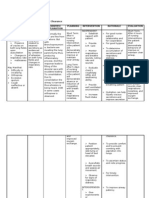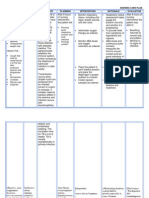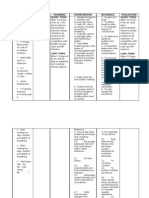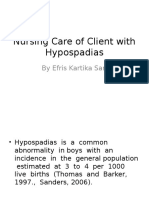Copd NCP
Copd NCP
Uploaded by
SuperMayeCopyright:
Available Formats
Copd NCP
Copd NCP
Uploaded by
SuperMayeOriginal Description:
Original Title
Copyright
Available Formats
Share this document
Did you find this document useful?
Is this content inappropriate?
Copyright:
Available Formats
Copd NCP
Copd NCP
Uploaded by
SuperMayeCopyright:
Available Formats
1
Malnutrition,
Assessment
Nursing Diagnosis Desired Outcome Nursing
Intervention
Rationale Outcome
Subjective:
Lagi lang siyang
nakahiga kasi
nahihirapan siyang
huminga at hinihingal
siya pero umuupo
siya pag kaya niya.
as verbalize by his
wife.
Objective:
T= 36.4 C
PR= 86 bpm
RR= 28 cpm
(Shallow)
BP= 140/80 mmHg
Physical
Assessment:
-Dyspnea.
-Symmetric
movement of chest
noted.
-Skin is intact.
-No lesions noted.
-No tenderness when
palpated.
INEFFECTIVE
AIRWAY
CLEARANCE
Related to:
Bronchospasm and
fatigue.
Secondary to:
Chronic Obstructive
Pulmonary Disease,
Community-Acquired
Pneumonia and
Pulmonary
Tuberculosis.
Possibly evidenced
by:
Tachypnea, shallow
respiration, dyspnea,
pallor, nasal
flaring,crackles and
wheezes and
abnormal use of
accessory muscle.
Short Term:
During the first 15
minutes of duty the
patient will verbalize
comfort and
demonstrate effective
breathing techniques.
Long Term:
During the 8 hours of
nursing intervention,
the client will:
Maintain patent
airway with breath
sounds clear.
Demonstrate
behaviors to improve
airway clearance by
effective coughing.
Respiratory rate is
within normal range.
Fever is not present.
Take all his
medication.
Maintained in a
minimal oxygen
support.
Independent:
-Assess and monitor
clients vital sign
paying attention to
respiration. Note the
pattern, depth,
volume.
-Auscultate lung
fields, noting area
with
decreased/absent
breath sounds and
adnetitous breath
sounds.
- Assess skin
complexion for pallor
and/or cyanosis
-Elevate head of bed.
-Educate/help the
client with deep
breathing exercises.
- Breathing pattern is
vital for clients
survival and may
result to poor tissue
perfusion.
-Decreased airflow
occurs in areas
consolidated with
fluids.
-manifestation of poor
tissue perfusion
-Lowers
diaphragm,promoting
chest expansion and
aeration of lung
segments.
-Deep breathing
facilitates maximum
expansion of the
lungs/smaller
airways.
2
-Decreased chest
expansion observed
and there is an
increased tactile
fremitus.
-Upon auscultation,
crackles and
wheezes heard.
-Productive cough
and used of
accessory breathing
muscles.
-Barrel chest.
-There is minimal
flaring of nares.
-Cool and clammy
skin.
-Pale skin color,
buccal mucosa and
conjunctiva.
-3 seconds delayed
capillary refill test.
-Slight clubbing of
finger nails.
-Weakness.
Not develop any
other complication.
-Demonstrate/assist
the client to perform
activities like splinting
chest and effective
coughing while in
upright position.
-Force fluids to
atleast 3000Ml/day.
Offer warm,rather
than cold fluids.
Collaborative
-Assist with/monitor
effects of nebulizer
treatments. Perform
treatments between
meals and limits
fluids when
appropriate.
-Administer
medications as
indicated.
-Coughing is a
natural self-clearing
mechanism,assisting
the cilia to maintain
patent airways.
Splinting reduces
chest discomfort and
upright position
favors deeper more
forceful cough effort.
-Fluids especially
warm liquids aid in
mobilization and
expectoration of
secretions.
-Facilitates
liquefaction and
removal of
secretions.
Coordination of
treatments/schedules
and oral intake
reduces likelihood of
vomiting with
coughing,
expectorations.
-Aids in reduction of
bronchospasm and
mobilization of
secretions.
3
-Fatigue.
-Lethargic. GCS of
11.
Laboratory:
-Decreased
hemoglobin(11.1 g/dl)
-Decreased
hematocrit (0.33)
-Decreased
lymphocytes (18%)
-Increased
Segmenters(82%)
-(+) PTB on chest x-
ray
-Decreased
potassium
(2.97 mmol/L)
-Compensated
Respiratory Acidosis
(pCO2 53.2 mmHg
and p02 165.5 mmHg
; pH 7.385)
-Provide
supplemental fluids
(IV and humidified
oxygen).
-Monitor laboratory
and radiology results
(cbc,pulse oximetry,
ABGs, chest x-rays
and CT scan.)
-Suction as indicated.
-Fluids are required
to replace losses and
aid in mobilization of
secretions.
-Follows progress
and effects of disease
process/therapeutic
regimen and
facilitates necessary
alterations in therapy.
-Stimulates cough or
mechanically clears
airway in patient who
is unable to do so
because of ineffective
cough or decreased
LOC.
4
Assessment Nursing Diagnosis Desired Outcome Nursing
Intervention
Rationale Outcome
Subjective:
Lagi lang siyang
nakahiga kasi
nahihirapan siyang
huminga at hinihingal
siya pero umuupo
siya pag kaya niya.
as verbalize by
clients wife.
Objective:
T= 36.4 C
PR= 86 bpm
RR= 28 cpm
(Shallow)
BP= 140/80 mmHg
Physical
Assessment:
-Dyspnea.
-Symmetric
movement of chest
noted.
-Skin is intact.
-No lesions noted.
-No tenderness when
palpated.
ACTIVITY
INTOLERANCE
Related to:
General weakness
and imbalance
between oxygen
supply and demand
Secondary to:
Chronic Obstructive
Pulmonary Disease,
Community-Acquired
Pneumonia and
Pulmonary
Tuberculosis.
Possibly evidenced
by:
Verbal reports of
weakness, fatigue,
exhaustion.
Exertional dyspnea
and tachypnea.
Short Term:
During the first 15
minutes of duty the
patient will verbalize
comfort and
cooperate to nursing
procedures with
minimal effort and will
respond positively to
assisted ADLs.
Long Term:
During the 8 hours of
nursing intervention,
the client will:
Report/demonstrate a
measurable increase
in tolerance to activity
with absence of
dyspnea and
excessive fatigue.
Vital signs within
patient acceptable
range.
Independent:
-Evaluate patients
response to activity.
Note reports of
dyspnea,increased
weakness/fatigue and
changes in vital signs
during and after
activities.
-Provide quiet
environment and limit
visitors during acute
phase as
indicated.Encourage
use of stress
management and
diversional activities
as appropriate.
-Explain importance
of rest in treatment
plan and necessity for
balancing activities
with rest.
-Establish patients
capabilities/needs
and facilitates choice
of intervention.
-Reduce stress and
excess stimulation,
promoting rest.
-Bedrest is
maintained during
acute phase to
decrease metabolic
demands thus
conserving energy for
healing. Activity
restrictions thereafter
determined by
individual patient
response to activity
and resolution of
respiratory
5
-Decreased chest
expansion observed
and there is an
increased tactile
fremitus.
-Upon auscultation,
crackles and
wheezes heard.
-Productive cough
and used of
accessory breathing
muscles.
-Barrel chest.
-There is minimal
flaring of nares.
-Cool and clammy
skin.
-Pale skin color,
buccal mucosa and
conjunctiva.
-3 seconds delayed
capillary refill test.
-Slight clubbing of
finger nails.
-Weakness.
-Assist patient to
assume comfortable
position for
rest/sleep.
-Assist with self care
activities as
necessary. Provide
for progressive
increase in activities
during recovery
phase.
insufficiency.
-Patient may be
comfortable with
head and bed
elevated, sleeping in
chair or leaning
forward on overhead
table with pillow
support.
-Minimizes
exhaustion and helps
balance oxygen
supply and demand.
6
-Fatigue.
-Lethargic. GCS of
11.
Laboratory:
-Decreased
hemoglobin(11.1 g/dl)
-Decreased
hematocrit (0.33)
-Decreased
lymphocytes (18%)
-Increased
Segmenters(82%)
-(+) PTB on chest x-
ray
-Decreased
potassium
(2.97 mmol/L)
-Compensated
Respiratory Acidosis
(pCO2 53.2 mmHg
and p02 165.5 mmHg
; pH 7.385)
7
Assessment Nursing Diagnosis Desired Outcome Nursing
Intervention
Rationale Outcome
Subjective:
Lagi lang siyang
nakahiga kasi
nahihirapan siyang
huminga at hinihingal
siya pero umuupo
siya pag kaya niya.
as verbalize by
clients wife.
Objective:
T= 36.4 C
PR= 86 bpm
RR= 28 cpm
(Shallow)
BP= 140/80 mmHg
Physical
Assessment:
-Dyspnea.
-Symmetric
movement of chest
noted.
-Skin is intact.
-No lesions noted.
-No tenderness when
palpated.
IMPAIRED GAS
EXCHANGE
Related to:
Alveolar-capillary
membrane changes.
Altered oxygen-
carrying capacity of
blood.
Altered delivery of
oxygen.
Secondary to:
Chronic Obstructive
Pulmonary Disease,
Community-Acquired
Pneumonia and
Pulmonary
Tuberculosis.
Possibly evidenced
by:
Dyspnea, lethargy
and pallor.
Short Term:
During the first 15
minutes of duty the
patient will verbalize
comfort and
demonstrate effective
breathing techniques.
Long Term:
During the 8 hours of
nursing intervention,
the client will:
Demonstrate
improved ventilation
and oxygenation of
tissues by ABGs
within patient
acceptable range and
absence of symptoms
of respiratory
distress.
Participate in actions
to maximize
oxygenation.
Independent:
-Assess respiratory
rate,depth and ease.
-Observe color of
skin, mucous
membrane, nailbeds
noting presence of
cyanosis.
-Assess mental
status.
-Monitor heart rate
and rhythm.
-Manifestation of
respiratory distress
are dependent on/
and indicative of the
degree of lung
involvement and
underlying general
health status.
-Cyanosis of nailbed
may represent
vasoconstriction or
bodys response to
fever or chills.
Cyanosis of buccal
mucosa, earlobes is
indicative of systemic
hypoxemia.
-Restlessness,
irritation, confusion,
and somnolence may
reflect hypoxemia/
decreased cerebral
oxygenation.
-Tachycardia is
usually present in
response to fever or
dehydration but may
represent a response
to hypoxemia.
8
-Decreased chest
expansion observed
and there is an
increased tactile
fremitus.
-Upon auscultation,
crackles and
wheezes heard.
-Productive cough
and used of
accessory breathing
muscles.
-Barrel chest.
-There is minimal
flaring of nares.
-Cool and clammy
skin.
-Pale skin color,
buccal mucosa and
conjunctiva.
-3 seconds delayed
capillary refill test.
-Slight clubbing of
finger nails.
-Weakness.
-Monitor body
temperature.
-Maintain bedrest.
-Elevate head and
encourage frequent
position changes,
deep breathing and
effective coughing.
-Assess level of
anxiety. Encourage
verbalization or
signage of
concerns/feelings.
-Observe
deterioration in
condition.
Collaborative:
-Monitor ABGs,
pulse oximetry.
-High fever greatly
affects metabolic
demands.
-Prevents
overexhaustion and
reduce oxygen
demands to facilitate
resolution of infection.
-To promote maximal
inspiration and
enhance
expectoration of
secretions.
-Anxiety is a
manifestation of
psychological
concerns and
physiological
response to hypoxia.
-Shock and
pulmonary edema are
the most common
causes of death in
pneumonia and
require immediate
medical intervention.
-Follows progress of
disease process and
facilitates alternations
9
-Fatigue.
-Lethargic. GCS of
11.
Laboratory:
-Decreased
hemoglobin(11.1 g/dl)
-Decreased
hematocrit (0.33)
-Decreased
lymphocytes (18%)
-Increased
Segmenters(82%)
-(+) PTB on chest x-
ray
-Decreased
potassium
(2.97 mmol/L)
-Compensated
Respiratory Acidosis
(pCO2 53.2 mmHg
and p02 165.5 mmHg
; pH 7.385)
-Administration of
appropriate oxygen
therapy. (Nasal
prongs in patients
case)
in pulmonary therapy.
-The purpose of
oxygen therapy is to
maintain Pa02 above
60mmHg. Oxygen is
administered by the
method that provides
appropriate delivery
within patients
tolerance.
10
Assessment Nursing Diagnosis Desired Outcome Nursing
Intervention
Rationale Outcome
Subjective:
Lagi lang siyang
nakahiga kasi
nahihirapan siyang
huminga at hinihingal
siya pero umuupo
siya pag kaya niya.
as verbalize by his
wife.
Objective:
T= 36.4 C
PR= 86 bpm
RR= 28 cpm
(Shallow)
BP= 140/80 mmHg
Physical
Assessment:
-Dyspnea.
-Symmetric
movement of chest
noted.
-Skin is intact.
-No lesions noted.
-No tenderness when
palpated.
RISK FOR SPREAD
OF INFECTION
Related to:
Presence of existing
infection. decreased
ciliary action and
stasis of respiratory
secretions.
Secondary to:
Chronic Obstructive
Pulmonary Disease,
Community-Acquired
Pneumonia and
Pulmonary
Tuberculosis.
Short Term:
During first 15
minutes of duty
patient will be aware
of factors that can
contribute to spread
of infection.
Long Term:
During the 8 hours of
nursing intervention,
the client will:
Achieve timely
resolution of current
infection without
complications.
Knowledge: Infection
Control
Identify interventions
to prevent/reduce
risk/spread
of/secondary
infection.
Independent:
-Monitor vital signs
closely, especially
during initiation of
therapy.
-Instruct patient
concerning the
disposition of
secretions (e.g.,
raising and
expectorating versus
swallowing) and
reporting changes in
color, amount, odor of
secretions.
-Demonstrate/
encourage good
handwashing
technique.
-Change position
frequently and
provide good
pulmonary toilet.
-Limit visitors as
indicated.
-During this period of
time, potentially fatal
complications
(hypotension/shock)
may develop.
-Although patient may
find expectoration
offensive and attempt to
limit or avoid it, it is
essential that sputum
be disposed of in a safe
manner. Changes in
characteristics of
sputum reflect
resolution of pneumonia
or development of
secondary infection.
-Effective means of
reducing spread or
acquisition of infection.
-Promotes
expectoration, clearing
of infection.
-Reduces likelihood of
exposure to other
infectious pathogens.
11
-Decreased chest
expansion observed
and there is an
increased tactile
fremitus.
-Upon auscultation,
crackles and
wheezes heard.
-Productive cough
and used of
accessory breathing
muscles.
-Barrel chest.
-There is minimal
flaring of nares.
-Cool and clammy
skin.
-Pale skin color,
buccal mucosa and
conjunctiva.
-3 seconds delayed
capillary refill test.
-Slight clubbing of
finger nails.
-Weakness.
-Institute isolation
precautions as
individually
appropriate.
-Encourage adequate
rest balanced with
moderate activity.
-Promote adequate
nutritional intake.
-Monitor
effectiveness of
antimicrobial therapy.
-Investigate sudden
changes/deterioration
in condition, such as
increasing chest pain,
extra heart sounds,
altered sensorium,
recurring fever,
changes in sputum
characteristics.
-Dependent on type of
infection, response to
antibiotics, patients
general health, and
development of
complications, isolation
techniques may be
desired to prevent
spread/protect patient
from other infectious
processes.
-Facilitates healing
process and enhances
natural resistance.
-Signs of improvement
in condition should
occur within 2448 hr.
-Delayed recovery or
increase in severity of
symptoms suggests
resistance to antibiotics
or secondary infection.
-Complications affecting
any/all organ systems
include lung
abscess/empyema,
bacteremia,
pericarditis/endocarditis,
meningitis/encephalitis,
and superinfections.
12
-Fatigue.
-Lethargic. GCS of
11.
Laboratory:
-Decreased
hemoglobin(11.1
g/dl)
-Decreased
hematocrit (0.33)
-Decreased
lymphocytes (18%)
-Increased
Segmenters(82%)
-(+) PTB on chest x-
ray
-Decreased
potassium
(2.97 mmol/L)
-Compensated
Respiratory Acidosis
(pCO2 53.2 mmHg
and p02 165.5
mmHg ; pH 7.385)
-Administer
antimicrobials as
indicated by results of
sputum/blood
cultures: e.g.,
penicillins:
erythromycin (E-
Mycin), tetracycline
(Achromycin),
doxycycline hyclate
(Vibramycin),
amikacin (Amikin);
cephalosporins:
ceftriaxone
(Rocephin);
amantadine
(Symmetrel);
sparfloxacin (Zagam);
macrolide derivatives,
e.g, azithromycin
(Zithromax).
-These drugs are used
to combat most of the
microbial pneumonias.
Combinations of
antiviral and antifungal
agents may be used
when the pneumonia is
a result of mixed
organisms. Vancomycin
and third-generation
cephalosporins are the
treatment of choice for
penicillin-resistant
streptococcal
pneumonia.
13
Assessment Nursing Diagnosis Desired Outcome Nursing
Intervention
Rationale Outcome
Subjective:
Nahirapan siyang
lumunok at kumain
kaya nilagyan siya ng
NGT. Minsan,
humihingi pa rin siya
ng kape o gatas pero
naka NGT na siya.
As verbalize by
patients wife.
Objective:
T= 36.4 C
PR= 86 bpm
RR= 28 cpm
(Shallow)
BP= 140/80 mmHg
Physical
Assessment:
-Difficulty on
swallowing.
-Dyspnea.
-Symmetric
movement of chest
noted.
-Skin is intact.
RISK FOR
ASPIRATION
Related to:
Copious and thick
secretion.
Difficulty on
swallowing.
Secondary to:
Chronic Obstructive
Pulmonary Disease,
Community-Acquired
Pneumonia and
Pulmonary
Tuberculosis.
Possibly evidence
by:
Dyspnea. Abnormal
breath sounds.
Lesser gag reflex.
Short term:
After 15 minutes of
nursing intervention
patients will be aware
of precautionary
measures to avoid
possible aspiration.
Long term:
After 8 hours of
nursing intervention
the patient will:
Maintain patent
airway with clear
breath sounds.
Demonstrate
behaviors to improve
airway clearance
within level of
ability/situation.
Independent:
-Assess respiratory
rate,depth and ease.
-Elevate head of bed
30-45 degrees.
-Encourage
swallowing if the
patient is able.
Collaborative:
-Suction oral and
nasal cavities. Note
amount,color and
consistency of
secretions.
-Provide
supplemental
humidification.
Increased fluid intake.
-Changes in
respirations, use of
accessory muscles
and presence of
adventitious breath
sounds suggest
retention of
secretions.
-Facilitates drainage
of secretion, work of
breathing and lung
expansion.
-Prevents pooling of
oral secretions,
reducing risk for
aspiration.
-Prevents secretion
from obstructing
airway.
-Supplemental
humidification
decreases mucous
crusting and
facilitates on
14
-No lesions noted.
-No tenderness when
palpated.
-Decreased chest
expansion observed
and there is an
increased tactile
fremitus.
-Upon auscultation,
crackles and
wheezes heard.
-Productive cough
and used of
accessory breathing
muscles.
-Barrel chest.
-There is minimal
flaring of nares.
-Cool and clammy
skin.
-Pale skin color,
buccal mucosa and
conjunctiva.
-3 seconds delayed
capillary refill test.
-Resume oral intake
with caution.
expectoration or
suctioning.
-Changes in muscle
strength and nerve
innervations increase
likelihood of
aspiration.
15
-Slight clubbing of
finger nails.
-Weakness.
-Fatigue.
-Lethargic. GCS of
11.
Laboratory:
-Decreased
hemoglobin(11.1 g/dl)
-Decreased
hematocrit (0.33)
-Decreased
lymphocytes (18%)
-Increased
Segmenters(82%)
-(+) PTB on chest x-
ray
-Decreased
potassium
(2.97 mmol/L)
-Compensated
Respiratory Acidosis
(pCO2 53.2 mmHg
and p02 165.5 mmHg
; pH 7.385)
16
You might also like
- Nursing Care Plan Chronic Obstructive Pulmonary Disease (COPD)Document2 pagesNursing Care Plan Chronic Obstructive Pulmonary Disease (COPD)deric95% (42)
- Nursing Care Plan Congestive Heart FailureDocument2 pagesNursing Care Plan Congestive Heart FailureRalph Dumawaa60% (5)
- Path CNS Robbins Outline: Owl Club Review Sheets 1Document37 pagesPath CNS Robbins Outline: Owl Club Review Sheets 1Coy NuñezNo ratings yet
- Impaired Gas Exchange PneumoniaDocument2 pagesImpaired Gas Exchange PneumoniaAngel Cabatingan100% (4)
- NCP For COPDDocument3 pagesNCP For COPDJeremiah M. Mascariñas89% (19)
- Ineffective Airway Clearance Related To BronchospasmDocument2 pagesIneffective Airway Clearance Related To BronchospasmReylan Garcia100% (4)
- Pneumonia-Ineffective Airway ClearanceDocument2 pagesPneumonia-Ineffective Airway ClearanceNursesLabs.com86% (7)
- NCP Impaired Gas ExchangeDocument1 pageNCP Impaired Gas ExchangeLaidy Aizahlyn Indoc Angod0% (3)
- Assessment Scientific Analysis Planning Intervention Rationale Evaluation Short Term GoalDocument4 pagesAssessment Scientific Analysis Planning Intervention Rationale Evaluation Short Term GoalJayson OlileNo ratings yet
- Assessment Diagnosis Planning Intervention Rationale EvaluationDocument4 pagesAssessment Diagnosis Planning Intervention Rationale EvaluationTrisha Suazo100% (1)
- NCPDocument2 pagesNCPDidith AbanNo ratings yet
- Nursing Care Plan:: Lopez, Maria Sofia B. 10/18/2020 3-BSN-B Prof. IsananDocument4 pagesNursing Care Plan:: Lopez, Maria Sofia B. 10/18/2020 3-BSN-B Prof. IsananSofia LopezNo ratings yet
- Chronic Obstructive Bronchitis Is An Inflammation of The BronchiDocument9 pagesChronic Obstructive Bronchitis Is An Inflammation of The Bronchiinamaliit100% (1)
- Chronic Obstructive Pulmonary Disease (COPD)Document1 pageChronic Obstructive Pulmonary Disease (COPD)Bheru LalNo ratings yet
- NCP Copd4Document15 pagesNCP Copd4Alessa Marie Crisostomo Salazar100% (1)
- Impaired Gas Exchange Pneumonia Nursing Care PlanDocument1 pageImpaired Gas Exchange Pneumonia Nursing Care Planjustin_saneNo ratings yet
- Nursing Care Plan: Cystic FibrosisDocument4 pagesNursing Care Plan: Cystic FibrosisYael EzraNo ratings yet
- NCP - CopdDocument3 pagesNCP - CopdhystericoNo ratings yet
- NCP For AsthmaDocument1 pageNCP For AsthmaMelvin Martinez100% (1)
- Asthma Risk For Activity IntoleranceDocument1 pageAsthma Risk For Activity IntoleranceWdy Tanakht Sparrow100% (4)
- Ineffective Airway ClearanceDocument1 pageIneffective Airway ClearancejomerdalonaNo ratings yet
- Nursing Care Plan - Ineffective Airway ClearanceDocument1 pageNursing Care Plan - Ineffective Airway ClearanceLei OrtegaNo ratings yet
- Ncp-Ineffective Breathing PatternDocument4 pagesNcp-Ineffective Breathing PatternRoxanne Ganayo Claver100% (1)
- Ineffective Breathing PatternDocument2 pagesIneffective Breathing PatternEna Katherine CanonoNo ratings yet
- NCP - CapDocument4 pagesNCP - CapSherryNo ratings yet
- Assessment Nursing Diagnosis Planning Nursing Intervention Rationale Evaluation Subjective DataDocument6 pagesAssessment Nursing Diagnosis Planning Nursing Intervention Rationale Evaluation Subjective DataDeinielle Magdangal RomeroNo ratings yet
- Impaired Gas ExchangeDocument2 pagesImpaired Gas ExchangeHanya Bint PotawanNo ratings yet
- PTB NCPDocument12 pagesPTB NCPNiel LeeNo ratings yet
- NCP Fdar Fin.Document8 pagesNCP Fdar Fin.Bissette DomingoNo ratings yet
- NCP CopdDocument6 pagesNCP Copdjoelette100% (1)
- Chronic Obstructive Pulmonary Disease (Bronchitis) Nursing Care PlansDocument10 pagesChronic Obstructive Pulmonary Disease (Bronchitis) Nursing Care PlansjamieboyRN100% (3)
- NCP PTBDocument2 pagesNCP PTBKath TalubanNo ratings yet
- Activity Intolerance NCPDocument3 pagesActivity Intolerance NCPGen Rodriguez100% (1)
- NCP PneumoniaDocument3 pagesNCP Pneumoniakaiserdominick100% (2)
- Assessment Diagnisis Planning Intervention Rationale Evaluation SubjectiveDocument2 pagesAssessment Diagnisis Planning Intervention Rationale Evaluation SubjectiveDanica Kate GalleonNo ratings yet
- ANOLIN, Marc Edriann T. Nursing Care Plan Assessmen T Diagnosis Rationale Planning Interventio N Rationale EvaluationDocument2 pagesANOLIN, Marc Edriann T. Nursing Care Plan Assessmen T Diagnosis Rationale Planning Interventio N Rationale EvaluationEdrianne Tui100% (2)
- FAELDONEA, PJ - Nursing Care PlanDocument6 pagesFAELDONEA, PJ - Nursing Care PlanPatricia Jean Faeldonea100% (1)
- Health Teaching Plan CalalangDocument5 pagesHealth Teaching Plan CalalangPhilip R. Marallag0% (1)
- NCP - Ineffective Airway ClearanceDocument3 pagesNCP - Ineffective Airway ClearanceHyacinth Gallardo Valino50% (2)
- Impaired Gas Exchange NCPDocument4 pagesImpaired Gas Exchange NCPkimglaidyl bontuyanNo ratings yet
- NCP TBDocument6 pagesNCP TBGrhace Aquino100% (3)
- Glaucoma NCPDocument4 pagesGlaucoma NCPChantal CaraganNo ratings yet
- CP Intestinal Obstruction Nursing Care PlanDocument7 pagesCP Intestinal Obstruction Nursing Care PlanShiella Heart MalanaNo ratings yet
- NCP Ineffective Airway Clearance Related To Lung Impairment PNEUMOTHORAXDocument5 pagesNCP Ineffective Airway Clearance Related To Lung Impairment PNEUMOTHORAXMa. Elaine Carla Tating0% (2)
- NCPDocument9 pagesNCPEjie Boy Isaga67% (3)
- Nursing Care Plan Ineffective Airway Clearance Related To Tracheobronchial Secretions CAPDocument2 pagesNursing Care Plan Ineffective Airway Clearance Related To Tracheobronchial Secretions CAPLP Benoza100% (2)
- NCP Impaired Gas ExchangeDocument2 pagesNCP Impaired Gas ExchangeGabriel Tolentino70% (10)
- Nursing Care Plan (Septick Shock)Document6 pagesNursing Care Plan (Septick Shock)REMILYN ROSE ASUNCION67% (9)
- Impaired Gas Exchange R/T Ventilation-Perfusion Imbalance Care PlanDocument2 pagesImpaired Gas Exchange R/T Ventilation-Perfusion Imbalance Care PlanCristina Centurion100% (10)
- Novilyn C. Pataray BSN - Ii Cystic Fibrosis: St. Paul College of Ilocos SurDocument1 pageNovilyn C. Pataray BSN - Ii Cystic Fibrosis: St. Paul College of Ilocos SurCharina AubreyNo ratings yet
- Liver Cirrhosis NCPDocument3 pagesLiver Cirrhosis NCPSharmaine MadlaNo ratings yet
- NCP CroupDocument3 pagesNCP Croupaurezea100% (3)
- NCP Tissue PerfusionDocument3 pagesNCP Tissue PerfusionKat Brija100% (1)
- Lopez, Maria Sofia B. 10/07/2020 3-BSN-B Prof. Zoleta: Nursing Care Plan: PneumoniaDocument9 pagesLopez, Maria Sofia B. 10/07/2020 3-BSN-B Prof. Zoleta: Nursing Care Plan: PneumoniaSofia Lopez100% (2)
- Assessment Diagnosis Planning Intervention EvaluationDocument2 pagesAssessment Diagnosis Planning Intervention EvaluationCharissa Magistrado De LeonNo ratings yet
- Bronchitis N C P BY BHERU LALDocument1 pageBronchitis N C P BY BHERU LALBheru LalNo ratings yet
- NCP - Ineffective Airway ClearanceDocument2 pagesNCP - Ineffective Airway Clearancelarapatricia1215No ratings yet
- Ineffective Breathing PatternDocument5 pagesIneffective Breathing PatternruguNo ratings yet
- Assessment Diagnosis Planning Implementation Rationale EvaluationDocument14 pagesAssessment Diagnosis Planning Implementation Rationale EvaluationJennifer ArdeNo ratings yet
- Nursing Care Plan Problem: Difficulty of BreathingDocument5 pagesNursing Care Plan Problem: Difficulty of BreathingIvan Louise Fajardo ManiquizNo ratings yet
- Activity Intolerance NCPDocument6 pagesActivity Intolerance NCPDoo NahNo ratings yet
- Nursing Care PlanDocument4 pagesNursing Care PlanAdreanah Martin RañisesNo ratings yet
- TRIAZOLAMDocument4 pagesTRIAZOLAMEzequiel RosalesNo ratings yet
- Vital Signs Flow SheetDocument3 pagesVital Signs Flow SheetGalenn Barrion0% (1)
- Protocol'S Treatments: 360° TAT (Turn Around Treatment)Document6 pagesProtocol'S Treatments: 360° TAT (Turn Around Treatment)mack132No ratings yet
- Oral Mucosal Changes Associated With FluDocument4 pagesOral Mucosal Changes Associated With FluManar AlsoltanNo ratings yet
- Nursing Care of Client With HypospadiaDocument21 pagesNursing Care of Client With HypospadiaancoursNo ratings yet
- AsDocument48 pagesAsCyndi CastañerosNo ratings yet
- Journal of Pediatric Surgery: Wendy K. Fujioka, Robert A. CowlesDocument3 pagesJournal of Pediatric Surgery: Wendy K. Fujioka, Robert A. CowlesVmiguel LcastilloNo ratings yet
- Assignment 3 - Clas 120Document9 pagesAssignment 3 - Clas 120KrushangiNo ratings yet
- Fixed Drug Eruption (Fde) : Health ProblemsDocument3 pagesFixed Drug Eruption (Fde) : Health ProblemsAimie Farhanah Binti Zakaria50% (2)
- SQR Symptom QuestionnaireDocument1 pageSQR Symptom QuestionnaireJenny AlvarezNo ratings yet
- CgaDocument13 pagesCgaBryan DG100% (1)
- Levels of Care Promotive: DEXA Scan - The Most Accurate Screening Test For Low Bone Strength Is A DualDocument2 pagesLevels of Care Promotive: DEXA Scan - The Most Accurate Screening Test For Low Bone Strength Is A DualLeogalvez BedanoNo ratings yet
- O5 Vo4No4Document6 pagesO5 Vo4No4Muthanna Lo'ayNo ratings yet
- 14: Drugs Used in Malignant Diseases and For ImmunosuppressionDocument36 pages14: Drugs Used in Malignant Diseases and For ImmunosuppressionleonNo ratings yet
- Module 2 HandoutDocument52 pagesModule 2 HandoutAmandaNo ratings yet
- Is Autism A Disability - How To Get Disability Benefits For Autism - AtticusDocument6 pagesIs Autism A Disability - How To Get Disability Benefits For Autism - AtticusijinkanNo ratings yet
- Grand Rounds 11 15 14Document4 pagesGrand Rounds 11 15 14api-272558411No ratings yet
- Jama Siegler 2024 Ed 240004 1706915651.01607Document2 pagesJama Siegler 2024 Ed 240004 1706915651.01607Srinivas PingaliNo ratings yet
- Expert WebsiteDocument6 pagesExpert Websiteapi-512227125No ratings yet
- Training Manual For Counselors PDFDocument197 pagesTraining Manual For Counselors PDFمخلص منيب اللهNo ratings yet
- Identifying Client at RiskDocument22 pagesIdentifying Client at RiskRon Ar IcaNo ratings yet
- Drug Study NubainDocument2 pagesDrug Study NubainNylia Atibi100% (1)
- 1 Chapter 1 Understanding Disability & Vulnerability FINAL - ppt-1Document29 pages1 Chapter 1 Understanding Disability & Vulnerability FINAL - ppt-1samuel abrehamNo ratings yet
- Basic Interpretation of CXRDocument84 pagesBasic Interpretation of CXRHaluk AlibazogluNo ratings yet
- Atypical EclampsiaDocument3 pagesAtypical EclampsiadianaristinugraheniNo ratings yet
- Halamang GamotDocument30 pagesHalamang GamotcabalidarealynNo ratings yet
- Parasitology: Prepared By: Charriz A. AmoyanDocument99 pagesParasitology: Prepared By: Charriz A. AmoyanRaphylyn EscalonaNo ratings yet
- RH Incompatibility Case StudyDocument14 pagesRH Incompatibility Case StudyMary Beth AbelidoNo ratings yet

























































































